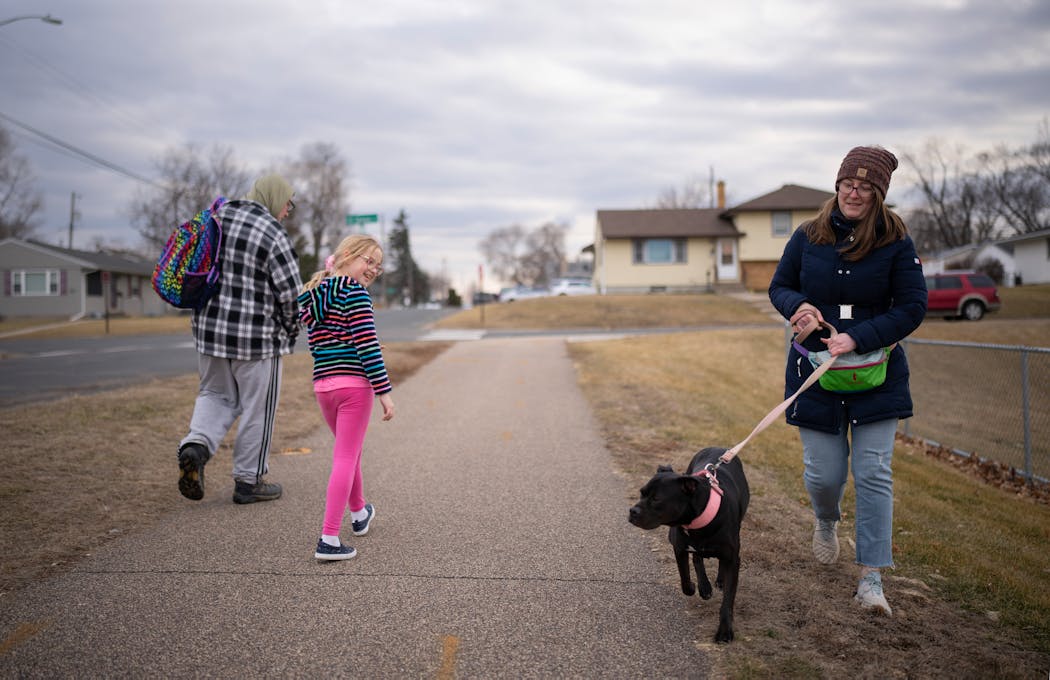Every time Abigail Turner starts to catch up on her debt, something happens.
She listens to financial podcasts. She makes a budget. She spends carefully. And then an ER visit or a pet expense or a layoff pops up, and she's behind again.
"It's like having a rock around your ankle: Everything you do, you have to factor in this rock," said the South St. Paul 29-year-old, who estimated she has about $50,000 in debt between student loans, credit cards and medical bills.
Turner is just one of the many Minnesotans struggling with managing debt. After declining early in the COVID-19 pandemic — when stimulus money and loan payment pauses buoyed personal balance sheets — U.S. consumer debt has swollen, with household debt reaching $17.5 trillion in the fourth quarter of 2023, up from $14.15 trillion in the fourth quarter of 2019, according to the Federal Reserve Bank of New York.
Nearly all states experienced an increase in per capita debt last year. In Minnesota, the total debt balance per capita in the fourth quarter was $62,680, up from $62,240 at the same time in 2022, the Fed data shows. Though that number has risen steadily in Minnesota since 2014, the data shows student loan and credit card balances declined between the fourth quarters of 2019 and 2020.
Consumer spending has stayed strong despite persistent inflation and elevated interest rates, but cracks are beginning to show, including an uptick in delinquency rates, declining personal savings and ballooning credit card debt. Mortgages comprise the lion's share of the U.S. consumer debt balance, but it's worrisome that credit cards are starting to eat up a bigger portion, said Tyler Schipper, an associate economics professor at the University of St. Thomas.
"I don't think we're at 'credit card debt is a systemic risk to the economy' yet," he said. "But those types of revolving debts, I think, are unfortunate features of the U.S. economy. And it can lead to some of the most heartbreaking stories around personal finances. They tend to affect the people that are least able to bear them."
Delinquencies rise
When the pandemic began, debt counselors at the nonprofit Lutheran Social Services (LSS) braced for the worst, said financial counseling supervisor Dan Park.
"We thought there would be a lot of scramble, and a lot of people like, 'Oh my goodness, what do we do? This is terrible, we have all these payments,' " he said. "But there was this unexpected quietness that happened."
The pause in federal student loan payments, banks implementing temporary forbearance plans and the windfall stimulus checks meant that fewer people needed help, Park said. Now that those programs have expired, LSS has "suddenly been starting to get really busy again," he said.
At the same time, clients are facing fresh challenges. There's been an uptick in online-based companies that woo consumers with a single loan to knock out all their debts at once, then refuse to negotiate if they're unable to make payments on that loan, Park said. On a broader scale, the higher cost of everything from utilities to groceries means it's harder to get by on a paycheck alone.
"All the expenses have gone up, and the wages haven't really caught up with that," Park said. "So something's got to give when there is more money being spent than is coming in. And that's usually when debt comes into play."
Increasingly, debt is becoming unmanageable. At the end of 2023, 3.1% of outstanding debt was delinquent, according to the New York Fed. On an annualized basis, about 8.5% of credit card debt and 7.7% of auto loans entered delinquency.
"Credit card and auto loan transitions into delinquency are still rising above pre-pandemic levels," Wilbert van der Klaauw, economic research adviser at the New York Fed, said in a statement. "This signals increased financial stress, especially among younger and lower-income households."
The extent of post-pandemic student loan delinquencies remains unclear because the U.S. Department of Education directed that student loan delinquencies not be reported to credit bureaus until Sept. 30.
'You get burned out'
Shorter-term and revolving loans, such as credit cards, have been more sensitive to the interest rate hikes the Fed has implemented to tame inflation.
"An important difference between, say, mortgages and auto loans, is that most of us with mortgages are still paying the low interest rates that predate the recent increases over the last few years," said Ryan Nunn, assistant vice president for applied research in community development and engagement at the Federal Reserve Bank of Minneapolis. "To the extent distress is being fed by higher interest rates that people face ... that's happening more quickly for autos than it would be for mortgages."
Though there was end-of-year optimism the Fed would lower rates early and often in 2024, the Federal Open Market Committee's January minutes show members are hesitant to cut too quickly.
But there's another factor at play, Nunn said, one often omitted from the narrative about consumers relying on debt after spending down pandemic savings.
"I think that that [narrative] misses something important, and that's the role of the robust labor market that we've had now for a little while in providing an ongoing flow of income that supports consumption," he said, noting wage growth for low-wage workers has also been relatively strong.
Still, for individuals focused on the economics of their own lives, making the numbers add up can feel impossible.
After leaving teaching for a career in sales in 2021 — before her company laid her off early last year — Turner is employed again and earning the most she ever has, but still feeling she's barely making do.
"We did everything we were told to do. We all went to college. We all got degrees. We all got those big, fancy, college-educated jobs," she said. "And we are living paycheck to paycheck."
On top of everything, there's the constant anxiety of her debt, and the worry that, when the other shoe drops, she'll be more behind than ever.
"You get burned out," Turner said. "It's like, why do I try to keep doing the 'proper thing' of paying all this down, when I feel like every time I try that, the system shows up to throw something else at me?"



